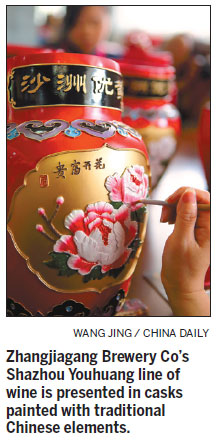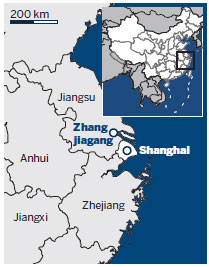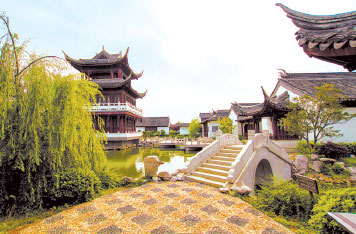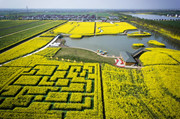Zhangjiagang Special:Traditional culture valued, promoted and preserved
( China Daily )
Updated: 2014-07-03
|
|||||||||
Huang Jiajia, a third-grade student from the Tangshi Elementary School, writes a Confucius quotation with her calligraphy brush during an extracurricular class.
The school in Zhangjiagang city, Jiangsu province, has a history going back more than a hundred years and was reconstructed in 2011.
Students are offered 56 different kinds of extracurricular activities, many of which are related to traditional Chinese art and culture. Classes include calligraphy, embroidery, martial arts, Chinese ancient instruments and Chinese traditional culture learning, said Chen Jing, the principal of the school.
The Zhangjiagang government put great effort into promoting and preserving traditional cultures at all levels, an official said.
According to the school, 73 percent of the school's students are children of new immigrants to the city.

"The students come from different parts of the country but we hope all of them have the opportunity to learn both modern and ancient Chinese culture here," Chen said.
For some activities, such as classic recitation, students wear traditional clothes to help them get into the spirit.
Buildings in the school also have an archaic touch and seven pavilions were built in accordance with ancient Chinese architecture styles, including the Shiyuan Garden, Liuyi Garden and Sixian Garden.
In Zhangjiagang, traditional culture is highly valued and well preserved in many areas.
Zhangjiagang Brewery Co is a local yellow wine producer with 120 years of history.
The company's wine is presented in cask-like containers decorated by traditional artists and the brewery uses traditional production processes.
The company's best-known line of wines, called Shazhou Youhuang, are presented in casks painted with Chinese elements, such as peonies, which symbolize wealth and happiness.
The brewery said yeast for the wine was made in the seventh lunar month and the wheat koji was made in the ninth lunar month.
After the yellow wine is pressed and boiled at the beginning of spring it is bottled and "covered with fragrant lotus leaves and then sealed with viscous loess mixed with pig blood or glutinous rice," a brewer said.
Zhangjiagang boasts several historical relics and in recent years historical sites and cultural heritage preservation have been a priority in the area.
The government has also focused on protecting the intangible cultural heritage.
Zhangjiagang city invested 300 million yuan ($50 million) in cultural resources protection in the past five years, according to a government report.
The Gold Village, an ancient village in the city, was built in the Jin Dynasty (AD 265-420) and has 1,000 years of history.
Many of the village's old streets and buildings were well preserved and residents have retained their customs and traditional lifestyles.

The shops, temples, houses and gardens in the Gold Village were all built in traditional southern China styles and some are relics from the Ming Dynasty (1368-1644) and Qing Dynasty (1644-1911).
In recent years, the local government built pseudo-classic sites, such as the Gold Village Agricultural Products Market, to maintain consistency in the village's architecture.
The Gold Village Temple Fair is a three-day celebration, which started during the Song Dynasty (960-1279), and is still held every year.
The fair was listed as one of the Jiangsu Intangible Cultural Heritages in 2011, according to the government.
Traditional local art forms, such as the Heyang folk song performance, are also protected.
According to the government, the folk song is the "oldest, longest and most complete folk song and most valuable spiritual wealth known, with a history of 6,000 years."
In 2009, the Heyang folk song exhibition hall was built.
The 3,803.5-square-meter building contains a Heyang folk song show room, folk customs gallery, historical relics exhibition and an academic research center training school.
The exhibition hall invites singers from surrounding areas to perform regularly.
The government built an ancient-style commercial street, called the Old Yangshe Street, in the center of the city in 2010.
The street was built in Ming and Qing architecture styles and covers an area of 19,000 square meters.
The street includes 10 buildings, each with two to four floors that are connected to each other with corridors.
According to the government, the street is "positioned as a business tourism culture feature block with a Suzhou traditional garden to help promote history and culture of the city".
zhuanti@chinadaily.com.cn
|
Old Yangshe Street offers food, entertainment and leisure. Wang Jing / China Daily |
|
Heyang Folk Song Exhibition Hall in Fenghuang. Popov Maxim / Kazakhstan-tengrinews Website |
|
Students wear traditional clothes for a classic recitation class at Tangshi Elementary School. Aung Htay Hlaing / The Myanmar Times |
(China Daily 07/03/2014 page15)










